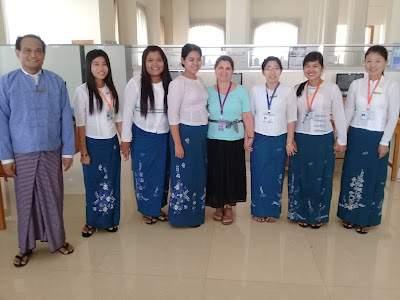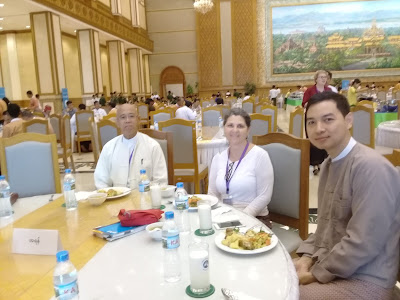There are no cows roaming the streets, or are lined neatly on the road across
from us waiting to be lead to their water post in the nearby ravine. There are
no milk apples nearby or in the village.
It’s Saturday! It’s early morning. A young Buddhist Monk, clad in a red maroon robe, strolls down on our street striking his triangular-brass-shaped gong with a small mallet emanating a sound that is both relaxing and calming. The gong’s chime, echoes energy across the narrow dirt road to alert the locals that a group of Monks, young and old, who rely heavily on the community for food donation, are about to do their regular rounds.
In the distance, possibly two houses across from us , nursery school children sing in Burmese to welcome the day. Whilst two boys, one of them carrying a little girl on his back, rush out of the house with a thud, giggling and echoing the Burmese chorus.
Contrary to the calming sound effect we heard earlier, motorcycles with passengers on back seats, rumble by to and fro the dirt road, and head to the market for fresh produce.
It’s Saturday! It’s early morning. A young Buddhist Monk, clad in a red maroon robe, strolls down on our street striking his triangular-brass-shaped gong with a small mallet emanating a sound that is both relaxing and calming. The gong’s chime, echoes energy across the narrow dirt road to alert the locals that a group of Monks, young and old, who rely heavily on the community for food donation, are about to do their regular rounds.
In the distance, possibly two houses across from us , nursery school children sing in Burmese to welcome the day. Whilst two boys, one of them carrying a little girl on his back, rush out of the house with a thud, giggling and echoing the Burmese chorus.
Contrary to the calming sound effect we heard earlier, motorcycles with passengers on back seats, rumble by to and fro the dirt road, and head to the market for fresh produce.
We've definitely
lucked out! We live in a little
community similar to rural Mondolkiri, Cambodia. We have an Asian style
bungalow surrounded by other humble homes.
It reminds me very much of our home in Mondolkiri, except that our home
here in Nay Pyi Taw is little grander and has a proper ceiling in the bathroom.
Our Mondolkiri bathroom had no ceiling, and as a result after every
shower , talcum-red-powedery- dust, if we weren’t swift
enough to escape the drizzly dust, sprayed down on our anticipated arched backs.
During our first week here, Kevin and I attended an expat dinner at one of the hotels to meet other working expats who most of them live in hotels during their stay here in Nay Pyi Taw. Fortunately, we live in our own little diamond in the rough where we can experience the real local Myanmar Asian lifestyle. By the way, there are several pockets, of other hidden treasures throughout Nay Pyi Taw, of little local communities like ours that are also tucked away from the main large multi-lane roads.
 Nay Pyi Taw,
built in 2005, and now the capital government base city of Myanmar, is semi
arid with fewer trees than Yangong. The
heat is unbearable with little shade wherever we are. Thankfully, the air con in our house was fixed
late last night. So, yes, we're very much looking forward to
the rainy season, which is suppose to start this coming week. With the rainy season, hopefully the rain
will cool things down, at least, for a little while .
Nay Pyi Taw,
built in 2005, and now the capital government base city of Myanmar, is semi
arid with fewer trees than Yangong. The
heat is unbearable with little shade wherever we are. Thankfully, the air con in our house was fixed
late last night. So, yes, we're very much looking forward to
the rainy season, which is suppose to start this coming week. With the rainy season, hopefully the rain
will cool things down, at least, for a little while .
I’ve been at
work, at the parliament for one week already and everyone is dressed impeccably. The women are clad in graceful aqua-blue
longyis that resembles the colour of the ocean. The longyi is embroidered with brilliant-white-sandy-blue peacock-like flowers that flow mid way up and around their lower part of their longyi. To compliment their smart-looking longyi,
the women wear an elegant chiffon white three quarter length sleeve blouse. The men’s attire is combined of a Mao- like blue jacket that is fastened with a Chinese
style cloth buttons and loops, and fits over a stiff white collared shirt . Their longyi is usually a dark reddish coloured
check-board. To set them apart
from departmental men staff, MP's not only wear a headdress that represents their ethnic origin, they also have a Mao-like jacket that is an earthen orange-colour and, a green-checkered longyi. A
longyi is simply a
sarong-like national dress that is worn by both men and women throughout
Myanmar to keep them cool in the heat.
So far, I’m fortunate to work with wonderful, thoughtful, humble and extremely helpful staffs. Together, we, some of the staff, colleagues and I have had lunch at the canteen where staff hand-in a ‘meal’ ticket for their lunch. Further, throughout my first week, we, and a group of NGO colleagues, went out for lunch to celebrate birthdays and other events. We also had lunch with MP’s to celebrate ‘World Milk Day’.

Initially we were a little apprehensive about what we were going to find in Nay PYi Taw. However, on our arrival, we were pleasantly surprised to find that Nay Pyi Taw is not an empty house/ or a ghostly town that people have claimed it to be. Equally pleased, I'm not the only, lonely car on the road ... There is indeed lighter traffic – at least compared to Yangon’s traffic.
All right, must
go before the Internet shuts down. Wishing
you fun reading and lots of laughter for
the next coming month.
More later ... :)















